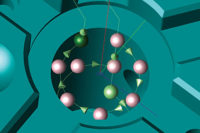But based on limited options, careful consideration and the need for highly accurate results, that's precisely the method Mark Williams, vice president of engineering at The Wilson Bohannan Co. (Marion, OH), chose to inspect their locks.
Wilson Bohannan was established more than 140 years ago. The company manufactures brass padlocks that are primarily used in industrial and utility applications. The locks are made on two large rotary transfer machines with drilling capabilities.
The waiting game
The primary mode of inspection had been to check diameters and hole locations by using a combination of pin gages and a special fixture fitted with dial indicators on a granite surface plate. The pin gages checked the diameters and the fixture, and determined the hole location.
"Total inspection time was three to four hours and that greatly hindered production," says Williams, "because the unit that machines the parts is set up and unable to be released for production until the first 10 pieces are successfully inspected and approved."
According to Williams, the inspection process was delaying the machine start up, which in turn was reducing the company's production yield. However, there were more problems than the initial runs. "After start up, we would perform periodic checks of parts, but we would continue to run the machine because of the lengthy inspection process," says Williams.
"Because our inspector couldn't check enough parts to ensure the quality we demanded, we were never completely comfortable with the results."
To make matters worse, there are areas of the holes such as at the bottom of the 0.111-inch diameter tumbler pin holes that are difficult to access and require destructive testing. "We had to cut apart locks to make accurate measurements," says Williams. It was clear that the inspection process had to change.
Coordinate measuring the way out
Williams first evaluated the lock's demanding accuracy requirements of + or - 1 to 2 thousandths for the hole diameter, and repeatability in half thousandths. He then took into consideration the physical attributes of the part and access to holes, both of which presented positioning and measuring approach problems.
"The lock tumbler pin holes had an opening of only 0.111 inch at the top and were 5/8-inch deep with the diameter of the hole at the bottom being critical," says Williams. "When we realized there was no way to conventionally hold the part and take measurements reliably and productively with repeatability, we began to see that a CMM that was direct computer controlled, which eliminated human intervention, would probably be our only alternative."
Still, there were hurdles to overcome, such as size. The typical CMM probe stylus tip alone is 0.08 inch, leaving a mere 15 thousandths clearance around the ruby tip in the hole. "After we found that the CMM offered a reliable fixturing base, that the stylus cleared the holes, and the measuring routines were automated and highly accurate, there was no doubt in my mind. A CMM was the only way to go," says Williams.
After reviewing various CMMs, Williams selected a Premis DCC model, with a 20-, 18- and 16-inch (X, Y, Z) measuring envelope and Apogee Software, both from The L.S. Starrett Co. (Athol, MA).
"We went with the Starrett CMM for a variety of reasons, but primarily because of their superior machine design and construction," says Williams. "For example, instead of aluminum, the machine is actually made of hollowed-out granite members, which make it lighter while being stable and repeatable. It's a well-built machine."
Productivity, quality unlocked
Another important benefit the CMM provides is the ability to deploy reverse engineering through the Apogee software. "Apogee improves productivity and accuracy," says Williams. "Now when we develop a new part, we do it first on the CAD system and export the CAD file in IGES format. Then we import the file to the Premis, grab the holes and diameters, and make instant inspections or evaluations.
Williams adds that the new software is easy for the operator to write and run part inspection programs.
Since their inspection process changed, Williams says that the system has paid for itself within the first two years. "The Starrett CMM has reduced the time it takes to inspect our locks to just a few minutes, which greatly saved on man-hours," says Williams.
Wilson Bohannan has also been able to deliver a higher quality product more consistently. "We now inspect locks with a higher level of accuracy," explains Williams. "Plus, with changeover times significantly reduced and the ability to quickly detect problems earlier in the production cycle, we are saving money while increasing our output."
Starrett Co., Metrology Systems Div.
(770) 590-7737
www.starrett.com
BENEFITS
The CMM reduced inspection time from three or four hours to a few minutes.
The system paid for itself in productivity gains in the first two years.
The system improved productivity and accuracy and allows reverse engineering capability.
